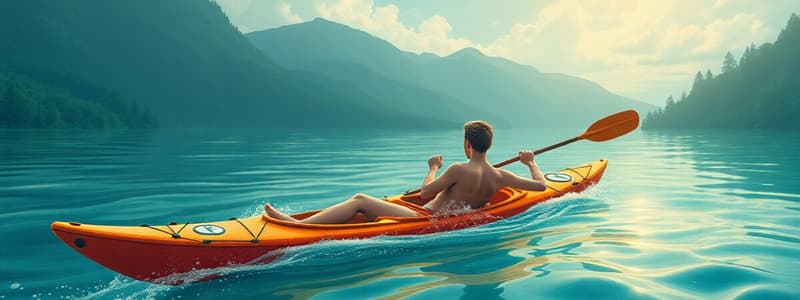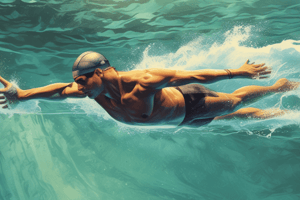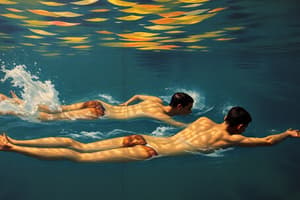Podcast
Questions and Answers
What is leisure?
What is leisure?
A time spent on activities not related to work and done for enjoyment and relaxation to feel refreshed.
Leisure is not an essential part of human life.
Leisure is not an essential part of human life.
False (B)
What is aquatics?
What is aquatics?
A broad term used for activities done in or on the water, including fitness swimming, water aerobics, synchronized swimming, and kayaking.
Which of the following is an example of aquatics recreational activity?
Which of the following is an example of aquatics recreational activity?
What is swimming?
What is swimming?
Which of these swimming styles is a competitive stroke?
Which of these swimming styles is a competitive stroke?
What is snorkeling?
What is snorkeling?
What is water aerobics?
What is water aerobics?
Which of the following is true about water aerobics?
Which of the following is true about water aerobics?
Which of the following is a benefit of water-based recreational activity?
Which of the following is a benefit of water-based recreational activity?
Which of the following is identified as a hazard of water-based recreational activity by the World Health Organization?
Which of the following is identified as a hazard of water-based recreational activity by the World Health Organization?
According to the WHO, approximately how many people worldwide die annually due to drowning?
According to the WHO, approximately how many people worldwide die annually due to drowning?
Which measure can help in reducing and preventing hazards in water-based recreational activities?
Which measure can help in reducing and preventing hazards in water-based recreational activities?
Flashcards
Recreational Activity
Recreational Activity
Activities done for enjoyment, relaxation, and refreshment, outside of work.
Aquatics
Aquatics
Activities done in or on the water.
Swimming
Swimming
Using one's body to move through water, often competitively.
Kayaking
Kayaking
Signup and view all the flashcards
Surfing
Surfing
Signup and view all the flashcards
Snorkeling
Snorkeling
Signup and view all the flashcards
Water Aerobics
Water Aerobics
Signup and view all the flashcards
Arthritis and Water Exercise
Arthritis and Water Exercise
Signup and view all the flashcards
Osteoarthritis benefits
Osteoarthritis benefits
Signup and view all the flashcards
Muscle strength and endurance
Muscle strength and endurance
Signup and view all the flashcards
Relieve stress
Relieve stress
Signup and view all the flashcards
Self-confidence and self-worth
Self-confidence and self-worth
Signup and view all the flashcards
Hazards of Water Activities
Hazards of Water Activities
Signup and view all the flashcards
Physical Hazards (Aquatics)
Physical Hazards (Aquatics)
Signup and view all the flashcards
Drowning
Drowning
Signup and view all the flashcards
Hazard Prevention
Hazard Prevention
Signup and view all the flashcards
First Aid techniques
First Aid techniques
Signup and view all the flashcards
Vigilant supervision
Vigilant supervision
Signup and view all the flashcards
Study Notes
- Leisure is time spent on activities for enjoyment and relaxation, not related to work.
- Leisure is an essential part of human life.
- Article 24 of the Universal Declaration of Human Rights states everyone has the right to rest and leisure.
Aquatics Recreational Activity
- Aquatics refers to activities done in or on the water.
- Aquatic activities include fitness swimming, water aerobics, synchronized swimming, and kayaking.
- The Philippines has over 7,641 islands, boasting diverse water forms.
- Swimming pools are accessible in many cities.
Examples of Water-Based Recreational Activity
Swimming
- It is an individual or team racing sport using the entire body.
- Competitive swimming is a popular Olympic sport with events like butterfly, backstroke, breaststroke, freestyle, and individual medley.
Kayaking
- Kayaking uses a kayak to move across water.
- A kayak is a low boat similar to a canoe where the paddler sits facing forward, using a double-bladed paddle.
Surfing
- Surfing involves riding waves in an upright or prone position.
- Surfers catch waves and glide across the water's surface until the wave breaks.
Snorkeling
- Snorkeling is swimming in water using a diving mask, a snorkel, and swim fins.
- A wetsuit may be worn in cooler waters.
Water Aerobics
- Water aerobics involves aerobic exercise in water (e.g., a pool).
- It is performed vertically in waist-deep or deeper water, which provides resistance training.
Benefits of Water-Based Recreational Activity
- Water-based exercise helps people with chronic diseases; for those with arthritis, improves the use of affected joints without worsening symptoms.
- People with arthritis have more health improvements after hydrotherapy than with other activities.
- Improves the use of affected joints and decreases pain from osteoarthritis.
- Increases muscle strength and endurance.
- Relieves stress.
- Enhances self-confidence and self-worth.
Hazards of Water-Based Recreational Activity
- Water-based activities offer health benefits but also pose hazards and risks.
- The World Health Organization (WHO) categorizes these hazards as physical, microbial, and chemical.
Physical Hazards
- Public swimming pools can present physical hazards like drowning/near-drowning, fall impact injuries, and injuries from poorly maintained water circulation systems.
- The WHO estimates that 372,000 people worldwide die annually due to drowning.
Reducing and Preventing Hazards (Physical)
On drowning and injuries:
- Teach participants about the risks so that they follow safety protocols.
- Inform individuals about basic lifesaving and first aid.
- Encourage vigilant supervision.
Studying That Suits You
Use AI to generate personalized quizzes and flashcards to suit your learning preferences.




